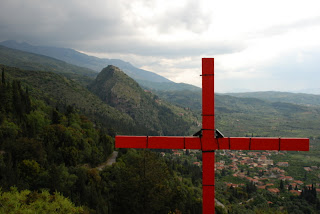


There was sunshine and blue skies when we woke up so we decided to go for a walk that we had found in the Municipality of Mystras tourist guide that we had been given at the campsite. We had also seen a board detailing the routes and spoken to a Dutch couple who had done one of the walks. We spotted a walk that we could take from the campsite and headed into the village. On the other side of Mystras on the way to the mediaeval site we turned left by an information board. The walk took us on a cobbled donkey track up a very pretty sheer-sided gorge with a stream flowing down it. The wild flowers were lovely and the route was lined with cyclamen. It is very late to see cyclamen growing in Greece but the cool Spring and the shaded nature of the gorge have probably allowed them to survive so long. As we approached the start of the walk we saw some dark clouds over the mountains and these increased as we progressed up the steep path. We passed many springs and chapels on the route and these provided an excuse for a break before continuing the climb. Near the top we came across signs of what might have been a wild boar with much disturbed soil and judging by the size of the stones moved it must have been a powerful animal.
After 2.5km and one and a half hours we arrived at a road just below the village of Taygeti and were informed by a sign that we were at an altitude of 700m. The village is very small but the views from it were lovely. We looked down on the castle of Mystras and across the modern village of Mystras and Sparta in the plain to the mountains beyond. They were covered in dense black cloud and we heard our first ominous deep rumble of thunder coming from across the valley. And then it started to rain, predictably at our furthest point from the campsite. Fortunately, it was only light rain and we started off on the long walk down the road from Taygeti down to Mystras. The road headed off in totally the wrong direction but descended slowly in zig-zags – easier walking but at least twice the distance of the route up. On this section there were herbs (mint, oregano and thyme) growing everywhere and we also saw lots of orchids. We left the road for a few metres to get to a small chapel with a view over the plain and came across a dead tortoise. The upper part of its shell had been smashed open and then the flesh eaten. We know that Golden Eagles prey on tortoises, they carry them up to a height and then drop them on rocks to break the shell. We also had a much nicer view of a tortoise, a live one this time, just a couple of minutes later. We had to shelter under the eaves of that chapel when a particularly heavy spate of rain fell accompanied by thunder and lightening and we used our very inelegant but effective rain capes (glorified plastic bags) for two stretches but got down to the plain without getting too wet. However, a huge mass of black cloud was heading towards us and it was a race to see who reached the campsite first. We won and it wasn't long before the rain started and it continued for the rest of the afternoon and into the evening.
Photos: We decided that this was the village square of Taygeti with a covered communal eating area; View down from Taygeti to Mystras Castle (left) and Sparta in the middle distance (right); View on our descent showing old and new Mystras.
No comments:
Post a Comment